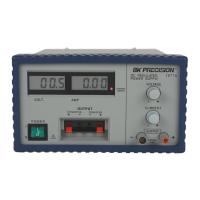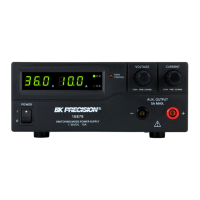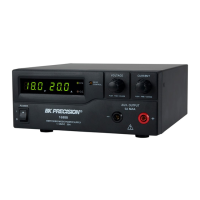The control Power winding of
Tl.
diodes
D9
and
DlO,
and filter capacitors Cl0 and
C11
form the
V+
and
V-
voltage source. These power source Cir-
cuits provide
+
15 and -15 volts respectively. Both
the
V+
and
V-
voltages float with respect
to
the
regulated output, and are also independent of the
variable unregulated B+ voltage.
CONTROL CIRCUITS
The control circuits convert the unregulated B+
voltage
into
the regulated
B+
voltage. The control
circuits establish the reguiated B+ level in
response
to
the
setting
of LEVEL control R27. When R27 is
set for
O
volts, the following circuit conditions
exist:
__Voltage
reference IC2 provides a stable
+7
V
reference at
IC2-6.
_The
+7
V reference is divided across R13 and
Rl4
to
place
+3.5
V on the inverting input (pin
4)
of
error amplifier IC2.
_The regulated B- output voltage is
0
V.
_The
+7
V reference is divided across current
path
I,.
which consists of
R15,
R27 (Approx-
imately 0 ohms at this time), R37 and R34. This
places approximately
+3.5
volts on the
non-
inverting input (pin 5) of error amplifier IC2.
__Since
the inverting and non-inverting inputs
to
IC2
are equal, no output is developed at
IC2-9.
_No
drive is applied to series pass regulator
Q1,
Q2 and the output remains at zero volts.
When LEVEL control Fi27 is increased to a higher
voltage level, the following circuit action
occurs:
__The
resistance of R27 is added to the voltage
divider network, decreasing current I,.
__The
voltage at
IC2-5
increased (less drop across
R15), and error amplifier IC2 produces an out-
put which biases regulator
Ql,
Q2
into oper-
ation.
__The
regulator allows some of the unregulated
B+
to pass to the output terminals and the out-
put voltage rises.
-As
the output voltage rises, the B- becomes
more negative.
-Current
Jr
increases as B- becomes more nega-
tive,
and the voltage at
IC2-5
decreases until
balance is achieved.
When LEVEL control R27 is decreased, the oppo-
site action occurs. Once
R27
is set and balance is
achieved, any load current changes that tend to
change the
output
voltage are sensed and corrected.
CURRENT SENSING CIRCUITS
The major components in the current sensing cir-
cui
t
s are comparator
IC1.
overload switch
SCRl,
and current sensing resistors
R1
thru R4. These
circuits monitor the load current and shut down the
power
supply
if the preset current limit is exceeded.
First, let us examine the current sensing resistors
R1
thru
R4.
These precision, low value resistors are
in
series with the
output
load current. The values
are
chosen so that the maximum current for a
chosen
range Produces exactly 1 volt drop
across
the
resistor (for example, if the 2A range is
selected
2
amps
through resistor R4 develops exactly
1
volt).
The voltage developed across the current
sensing resistor is applied as the non-inverting input
(pin 2) to comparator ICI.
The inverting input at pin 3 of comparator
ICl
is
a 0 to 1 volt dc potential selected by the SET CUR-
RENT LIMIT control R8.
Whenever the output load current produces a
voltage drop across the selected current sensing
resistor
(R1
thru R4) that is greater than the preset
voltage on the inverting input of
IC1,
a Positive out-
put voltage of approximately 1 volt appears at the
output (pin 7) of comparator
ICl.
This voltage
drives the gate of overload switch
SCR1
and turns
it on. Overload switch
SCRl
grounds pin
10
of error
amplifier IC2, which inhibits its operation regardless
of all other inputs and shuts down the power supply.
SCR1
also provides the ground path which allows
the OVERLOAD lamp to light. Set/reset switch S3
opens the voltage path to SCRI to reset it to an off
condition.
The STBY-DC ON switch
(S6)
is also connected to
pin
10
of error amplifier IC2. In the STBY position,
this switch grounds
IC2-10
and inhibits its operation,’
thus disabling the power supply output.
METERING
Voltmeter Ml is connected directly across the out-
put terminals to measure output voltage. Series
resistors, as selected by METER range switch S2,
calibrate the meter to read 0-25V or 0-5OV. A me-
chanical interlock prevents the LEVEL control from
being increased above approximately 25 volts when
S2 is in the 0-25V range.
Current meter M2 is actually a voltmeter that is
calibrated to accurately measure output load cur-
rent. The meter measures the voltage that is de
veloped across the current sensing resistor, which
is exactly 1 volt for a full scale meter reading.
When setting the current limit, switch S3 is actuated,
which connects the current meter directly across the
SET CURRENT LIMIT control R8. This control se-
lects a voltage from 0 to
lV,
which very accurately
corresponds to the current limit value read on the
meter.
